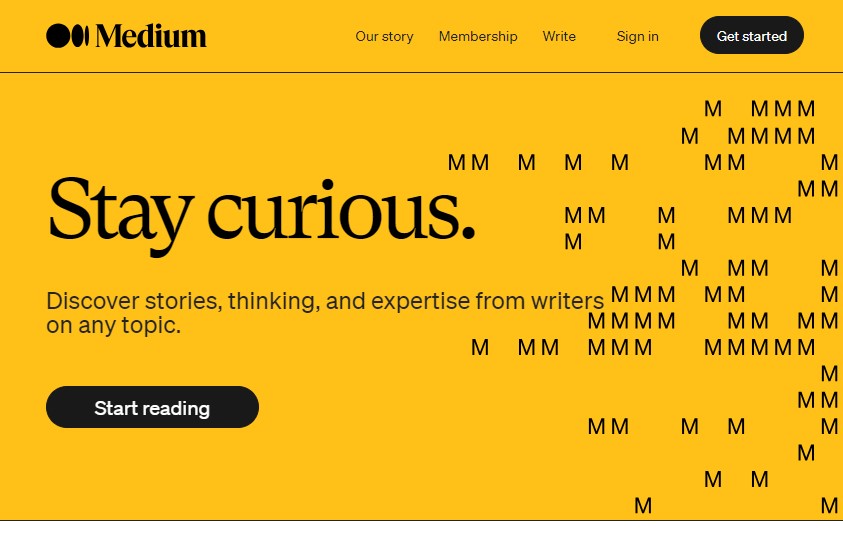Medium has rapidly emerged as a quintessential platform for both avid readers and prolific writers seeking to share and expand their insights across a myriad of topics. From personal narratives to comprehensive analyses, Medium offers a rich tapestry of articles that cater to a diverse audience. Its user-friendly interface and community-driven approach make it a preferred choice for anyone looking to engage with content on a deeper level.
Despite its popularity, Medium employs a model that might limit accessibility for some users: the paywall. A paywall is a method of restricting access to content via a paid subscription; on Medium, this means that only subscribers can access certain premium articles. This strategy not only helps sustain the platform and its contributing writers but also ensures that content creators are compensated for their efforts.
However, the presence of paywalls can be a barrier for users who cannot afford the subscription or who prefer not to commit financially. As a result, there is a growing interest among some segments of the Medium audience in finding ways to bypass these paywalls. While the motivation to access free content is understandable, it raises several legal, ethical, and security considerations that users need to be aware of before attempting to circumvent these restrictions.
Table of Contents
ToggleUnderstanding Paywalls on Medium
Paywalls are digital barriers set up by publishers to limit access to content, requiring readers to purchase a subscription to read the full articles. On Medium, paywalls play a critical role in the platform’s monetization strategy. When a reader encounters a paywalled article, they are typically able to read a snippet or an abstract of the content. However, to access the full text, a subscription to Medium’s membership program is necessary. This model encourages readers to support the ecosystem that directly compensates writers.
Medium uses paywalls primarily as a means to generate revenue, which is then shared with writers based on how much engagement their articles receive from paying members. This system incentivizes writers to produce high-quality, compelling content while also helping to sustain the platform’s operational costs. The revenue-sharing model is designed to be transparent and equitable, reflecting Medium’s commitment to supporting both emerging and established writers.
Regarding the prevalence of paywalled content on Medium, statistics reveal a significant portion of the articles are behind paywalls. While exact figures can fluctuate, it has been noted that around one-third of the articles on Medium are paywalled, necessitating a subscription for full access. This statistic underscores the platform’s reliance on subscriptions for revenue generation and highlights the importance of the paywall system in maintaining a viable business model that benefits all stakeholders involved.
Legal and Ethical Considerations
Legality of Bypassing Paywalls
The legality of bypassing paywalls varies significantly across different jurisdictions, reflecting the complex landscape of digital content laws. In many areas, circumventing paywalls can be considered a violation of the terms of service of a website, which users agree to upon creating an account or using the platform. Legal actions can be taken against users who employ software or methodologies to override these digital barriers, as this practice can be seen as unauthorized access under computer fraud and abuse laws.
In the United States, for instance, the Computer Fraud and Abuse Act (CFAA) could theoretically apply to the unauthorized circumvention of paywalls, as this act prohibits accessing computer systems without authorization. While prosecution under this law for merely bypassing a paywall is rare, it remains a legal risk that users need to consider. European countries may also see similar legal frameworks where the breach of digital services’ terms can lead to penalties.
Ethical Implications
Beyond legality, the ethical implications of circumventing paywalls strike at the heart of the content creation ecosystem. Paywalls are not only a revenue stream but also a way to ensure that content creators are fairly compensated for their efforts. By bypassing paywalls, users are enjoying the benefits of someone’s work without providing the due compensation that might be critical for the creators’ financial sustainability.
This practice can negatively impact the platform as well. Medium relies on subscription fees to operate and pay its staff, maintain its technology, and invest back into the community. Diminishing this revenue stream can lead to reduced service quality, fewer features, or in extreme cases, could jeopardize the platform’s viability.
Moreover, there is a moral aspect to consider regarding respect for the creators’ and platform’s rights. Writers choose platforms like Medium partly because of the potential earnings from paid subscriptions. When users bypass paywalls, they undermine this fundamental agreement, potentially discouraging writers from contributing further and harming the overall quality and diversity of content available.
Common Methods Used to Bypass Medium Paywalls
While the legality and ethics of bypassing paywalls are complex, various methods are commonly used to access paywalled content on platforms like Medium. It’s important to note that discussing these methods is not an endorsement of their use, but rather an exploration of the practices some users might employ.
Browser Incognito Mode
One of the simplest methods attempted to bypass paywalls is using a browser’s incognito mode. This feature allows users to browse the internet without the browser saving any history, cookies, site data, or information entered in forms. On some sites, paywalls track the number of free articles a reader has accessed using cookies. By switching to incognito mode, users might sometimes reset this count, potentially regaining access to content.
However, Medium’s paywall system is more sophisticated than simple cookie-based tracking. The platform typically requires users to log in to view premium content, which means that incognito mode alone is not effective at bypassing Medium paywalls.
Using Multiple Accounts
Another method is creating multiple accounts. Some users register more than one account with different email addresses to multiply their access to free articles offered by Medium before hitting the paywall. This strategy, however, has clear limitations and drawbacks:
- Management Overhead: Managing multiple accounts can be cumbersome, requiring different login credentials and possibly even different browsers or clearing cookies regularly.
- Limited Efficacy: Medium may track and limit the number of articles accessible per device or IP address, reducing the effectiveness of this method.
- Violation of Terms: This approach often violates the terms of service of the platform, which could lead to all associated accounts being banned.
Extensions and Tools
There are various browser extensions and tools designed specifically to bypass paywalls. These extensions might work by blocking the script that enforces the paywall or by manipulating cookies and other site data. Some popular extensions claim to allow users unrestricted access to content on many news and content platforms, including Medium.
However, the use of such tools comes with significant risks:
- Security Risks: Installing third-party extensions can expose users to security vulnerabilities, including the risk of malware or unauthorized data access.
- Legal and Ethical Concerns: As previously discussed, using these tools can be illegal in some jurisdictions and almost always breaches the terms of service agreements.
- Reliability: Publishers continuously update their paywall technologies to counteract such bypass methods, meaning that an extension that works today may not work tomorrow.
Risks Associated with Bypassing Paywalls
While the allure of free access to premium content can be tempting, bypassing paywalls carries significant risks that users should be aware of. These risks not only involve potential legal consequences but also expose users to security vulnerabilities and privacy issues. Understanding these risks can help inform more secure and ethical decisions when accessing content online.
Potential Legal Risks and Penalties
Bypassing paywalls can lead to legal issues, particularly in jurisdictions with strict digital content laws. As previously mentioned, practices such as using unauthorized tools to circumvent paywalls may violate terms of service and can also be seen as breaches of computer misuse or fraud laws, such as the Computer Fraud and Abuse Act in the United States. Users may face several legal consequences, including:
- Service Bans: Users can be permanently banned from the content platform for violating its terms of service.
- Legal Action: In severe cases, publishers might take legal action against individuals who bypass paywalls, leading to lawsuits or fines.
- Criminal Charges: Although rare, there is a potential for criminal charges if the action is considered a severe breach of digital security laws.
Security Risks from Using Third-Party Tools and Extensions
Third-party tools and browser extensions that claim to bypass paywalls pose several security risks. These tools often require permissions to modify website data and access browser activity, which can lead to unintended vulnerabilities:
- Malware Risks: Some tools may be disguised malware designed to steal personal information, inject malicious code, or hijack browser sessions.
- Data Breaches: By allowing third-party extensions broad access to your browsing data, you risk exposing sensitive personal information to unknown parties.
- Unreliable Software: Many of these tools are not maintained by reputable developers, meaning that they could break or become harmful without ongoing updates.
Impact on Personal Data Privacy
The methods used to bypass paywalls can also compromise your data privacy. Incognito modes and multiple account strategies often require users to disable certain security features, potentially leaving personal data exposed:
- Tracking and Profiling: Even when using incognito mode, users can be susceptible to IP-based tracking and profiling by other sites.
- Information Leakage: Using multiple accounts might lead to confusion and errors in handling login credentials, increasing the risk of accidentally leaking personal information.
- Cookie Manipulation: Some bypass methods involve manipulating cookies, which can inadvertently affect other site functionalities and privacy settings.
Alternative Legal Ways to Access Medium Content
For those seeking access to the rich content available on Medium without bypassing paywalls illegally, there are several legal alternatives that provide both access and support for the content creators and the platform. These methods ensure you remain compliant with the law and ethical standards, while still enjoying the full range of articles and writings Medium has to offer.
Medium’s Own Membership Model
Medium offers a membership program that is designed to be both affordable and beneficial for avid readers. For a monthly or annual fee, members gain unlimited access to all articles on the platform, including those behind paywalls. Here are the key benefits:
- Unlimited Reading: Members can read as much as they want across the platform without encountering paywalls.
- Supporting Writers: Your membership fees contribute directly to the writers you read most, as Medium compensates authors based on engagement from paying members.
- Exclusive Content: Some writers publish articles that are only available to Medium members, providing more value to subscribers.
- Cost: The membership fee is typically priced to be accessible, often less than the cost of a paperback book, making it a worthwhile investment for regular readers.
Partnership Programs and Promotions That Offer Free Access
Medium occasionally partners with other companies and organizations to offer promotional access. These partnerships may include:
- Bundled Subscriptions: Some services bundle Medium memberships with other subscriptions, such as educational resources or technology tools.
- Promotional Offers: Medium sometimes runs promotions where new users can get a limited-time free membership or existing members can gift a subscription to others.
- Special Events: During special events or for certain campaigns, Medium may offer temporary access to premium content without a subscription.
These partnerships and promotions are excellent ways to explore Medium’s premium content without a long-term commitment and can provide a gateway to discovering new writers and topics.
Public Libraries and Educational Accounts That Provide Free Access to Medium
Many public libraries and educational institutions offer access to databases and content platforms through their own subscriptions. Here’s how you can leverage these resources:
- Library Cards: Some public libraries provide their members with access to digital content, including subscriptions to platforms like Medium. Check with your local library to see if such options are available.
- Educational Access: Universities and colleges often subscribe to various journals and platforms. Students and faculty might have free access through their institution’s library services.
- Research Accounts: For researchers, access to platforms like Medium can sometimes be obtained through research grants or departmental resources.
How to Support Content Creators While Accessing Free Content
Supporting content creators is crucial to sustaining the quality and diversity of the material they produce, especially when accessing content freely or through promotions. Here are some effective strategies to ensure that creators are supported both financially and morally, balancing the benefits of free access with ethical support.
Importance of Supporting Content Creators Financially
Financial support is the backbone of sustainability for content creators. It enables them to dedicate time to their craft, cover their operational costs, and continue producing content that educates, informs, and entertains. Here’s why financial support matters:
- Sustainable Creation: Regular income allows creators to focus on maintaining and improving the quality of their content rather than dividing their efforts across multiple part-time jobs.
- Quality and Innovation: Financially supported creators are more likely to invest in better tools and resources, leading to higher quality and more innovative content.
- Community Growth: When creators are supported, they can also afford to engage more with their audience, fostering a vibrant, interactive community.
Alternative Support Methods
If direct financial support isn’t feasible, there are other meaningful ways to support content creators:
- Sharing Articles: Spreading their work through social media or word of mouth can significantly increase a creator’s exposure and audience size.
- Engaging with Content: Commenting on articles, participating in discussions, and providing feedback are all valuable to creators. Engagement helps boost the visibility of their content on platforms like Medium, which often leads to more readers and, potentially, more subscribers.
- Credit and Attribution: Always credit creators when sharing their work and encourage others to check out their original articles. This not only respects the creator’s rights but also promotes ethical content consumption.
Balancing Free Access with Ethical Support to Creators
While accessing free content, it’s important to maintain an ethical approach that supports content creators:
- Utilize Promotions Ethically: When using promotional access, engage actively and positively with the content. If a promotion includes a trial subscription, consider converting it into a paid subscription if you find the content valuable.
- Advocate for Creator Support Programs: Encourage platforms to implement and expand creator support programs. Some platforms offer mechanisms to tip or thank creators directly, even if you accessed their content for free.
- Educate Others About Supporting Creators: Spread awareness about the importance of supporting content creators among your networks. Educating others can lead to a broader cultural shift towards more sustainable content consumption.
Conclusion
In exploring the complexities surrounding the access and distribution of content on platforms like Medium, it’s clear that while there are ways to bypass paywalls, such practices come with significant legal, ethical, and security risks. We’ve discussed various aspects of accessing content through both unauthorized methods and legitimate alternatives, underscoring the importance of supporting the creators who make these platforms valuable.
Recap of Key Points:
- Understanding Paywalls: Paywalls are essential for platforms like Medium to ensure that creators are compensated for their work, supporting the overall quality and sustainability of the content.
- Risks of Bypassing Paywalls: While methods exist to circumvent these paywalls, they pose legal threats, security vulnerabilities, and ethical dilemmas that can undermine the integrity of both users and the platform.
- Legal Alternatives: We highlighted several legal ways to access Medium content, including subscriptions, promotional partnerships, and institutional access through libraries and educational bodies, which provide a balance between free access and financial support for creators.
- Supporting Creators: Beyond financial support, engaging with content, sharing articles, and crediting creators are crucial ways to contribute to the sustainability of their work and the vibrancy of the community.
FAQs
- What is a Medium article bypass?
A Medium article bypass refers to methods used to access paywalled content on Medium without a subscription. - Is bypassing Medium paywalls legal?
The legality of bypassing paywalls varies by jurisdiction, but it often violates terms of service and can lead to legal consequences. - What are the risks of using third-party tools to bypass Medium paywalls?
Using third-party tools can expose users to security risks like malware and data breaches, and may also be illegal. - How does Medium enforce its paywalls?
Medium uses a combination of account tracking and device identification to enforce paywalls, limiting the effectiveness of simple bypass methods like incognito browsing. - Are there ethical concerns with bypassing Medium’s paywalls?
Yes, bypassing paywalls undermines the revenue model that compensates creators and sustains the platform, posing significant ethical issues. - What are some legal ways to access Medium content without a subscription?
Legal methods include using Medium’s own membership program, accessing promotional offers, or using institutional accounts through libraries or schools. - How can I support Medium writers while accessing free content?
Engaging with content through likes, comments, and shares, and participating in discussions can help increase a creator’s visibility and indirectly support them. - Can I get in trouble for sharing methods to bypass Medium paywalls?
Sharing methods to bypass paywalls can spread practices that are potentially illegal and definitely against Medium’s terms of service. - What is Medium’s membership model?
Medium’s membership model requires a monthly or annual fee that provides unlimited access to all paywalled content and directly supports writers. - Why does Medium use paywalls?
Medium uses paywalls as a way to ensure writers are compensated for their work, helping to maintain high-quality content on the platform.







